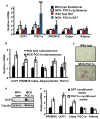A PGC1-α-dependent myokine that drives brown-fat-like development of white fat and thermogenesis
- PMID: 22237023
- PMCID: PMC3522098
- DOI: 10.1038/nature10777
A PGC1-α-dependent myokine that drives brown-fat-like development of white fat and thermogenesis
Abstract
Exercise benefits a variety of organ systems in mammals, and some of the best-recognized effects of exercise on muscle are mediated by the transcriptional co-activator PPAR-γ co-activator-1 α (PGC1-α). Here we show in mouse that PGC1-α expression in muscle stimulates an increase in expression of FNDC5, a membrane protein that is cleaved and secreted as a newly identified hormone, irisin. Irisin acts on white adipose cells in culture and in vivo to stimulate UCP1 expression and a broad program of brown-fat-like development. Irisin is induced with exercise in mice and humans, and mildly increased irisin levels in the blood cause an increase in energy expenditure in mice with no changes in movement or food intake. This results in improvements in obesity and glucose homeostasis. Irisin could be therapeutic for human metabolic disease and other disorders that are improved with exercise.
Conflict of interest statement
The authors have no financial interest to disclose.
Figures






Comment in
-
Basic research: Irisin--behind the benefits of exercise.Nat Rev Endocrinol. 2012 Jan 31;8(4):195. doi: 10.1038/nrendo.2012.11. Nat Rev Endocrinol. 2012. PMID: 22290362 No abstract available.
-
Metabolic disease: Exercise hormone fights metabolic disease.Nat Rev Drug Discov. 2012 Feb 17;11(3):189. doi: 10.1038/nrd3686. Nat Rev Drug Discov. 2012. PMID: 22338642 No abstract available.
-
Irisin, turning up the heat.Cell Metab. 2012 Mar 7;15(3):277-8. doi: 10.1016/j.cmet.2012.02.010. Cell Metab. 2012. PMID: 22405065
-
Is irisin a human exercise gene?Nature. 2012 Aug 30;488(7413):E9-10; discussion E10-1. doi: 10.1038/nature11364. Nature. 2012. PMID: 22932392 No abstract available.
Similar articles
-
Thermogenic capacity is antagonistically regulated in classical brown and white subcutaneous fat depots by high fat diet and endurance training in rats: impact on whole-body energy expenditure.J Biol Chem. 2014 Dec 5;289(49):34129-40. doi: 10.1074/jbc.M114.591008. Epub 2014 Oct 25. J Biol Chem. 2014. PMID: 25344623 Free PMC article.
-
Differentiation and characterization in primary culture of white adipose tissue brown adipocyte-like cells.Int J Obes (Lond). 2009 Jun;33(6):680-6. doi: 10.1038/ijo.2009.46. Epub 2009 Mar 10. Int J Obes (Lond). 2009. PMID: 19274054
-
Retinoic acid has different effects on UCP1 expression in mouse and human adipocytes.BMC Cell Biol. 2013 Sep 23;14:41. doi: 10.1186/1471-2121-14-41. BMC Cell Biol. 2013. PMID: 24059847 Free PMC article.
-
UCP1: its involvement and utility in obesity.Int J Obes (Lond). 2008 Dec;32 Suppl 7(Suppl 7):S32-8. doi: 10.1038/ijo.2008.236. Int J Obes (Lond). 2008. PMID: 19136989 Free PMC article. Review.
-
Transcriptional regulation of the uncoupling protein-1 gene.Biochimie. 2017 Mar;134:86-92. doi: 10.1016/j.biochi.2016.09.017. Epub 2016 Oct 5. Biochimie. 2017. PMID: 27693079 Review.
Cited by
-
Irisin promotes intestinal epithelial cell proliferation via Wnt/β-catenin and focal adhesion kinase signaling pathways.Sci Rep. 2024 Oct 28;14(1):25702. doi: 10.1038/s41598-024-76658-6. Sci Rep. 2024. PMID: 39465344 Free PMC article.
-
Subacute Effects of Moderate-Intensity Aerobic Exercise in the Fasted State on Cell Metabolism and Signaling in Sedentary Rats.Nutrients. 2024 Oct 18;16(20):3529. doi: 10.3390/nu16203529. Nutrients. 2024. PMID: 39458523 Free PMC article.
-
Positive Effects of Aerobic-Resistance Exercise and an Ad Libitum High-Protein, Low-Glycemic Index Diet on Irisin, Omentin, and Dyslipidemia in Men with Abdominal Obesity: A Randomized Controlled Trial.Nutrients. 2024 Oct 14;16(20):3480. doi: 10.3390/nu16203480. Nutrients. 2024. PMID: 39458475 Free PMC article. Clinical Trial.
-
Exercise, Neuroprotective Exerkines, and Parkinson's Disease: A Narrative Review.Biomolecules. 2024 Sep 30;14(10):1241. doi: 10.3390/biom14101241. Biomolecules. 2024. PMID: 39456173 Free PMC article. Review.
-
Adipose Tissue Plasticity: A Comprehensive Definition and Multidimensional Insight.Biomolecules. 2024 Sep 27;14(10):1223. doi: 10.3390/biom14101223. Biomolecules. 2024. PMID: 39456156 Free PMC article. Review.
References
-
- Puigserver P, et al. A cold-inducible coactivator of nuclear receptors linked to adaptive thermogenesis. Cell. 1998;92:829–839. - PubMed
Publication types
MeSH terms
Substances
Grants and funding
LinkOut - more resources
Full Text Sources
Other Literature Sources
Molecular Biology Databases
Research Materials

